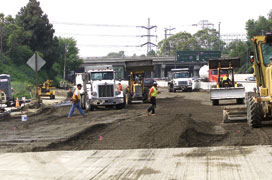 |
| Progress. Negotiators appear to have settled on $286.5-billion total obligation limit. (Photo courtesy of CALTRANS by Steve DeVorkin) |
In a floor statement around midnight on June 30 listing House of Representatives accomplishments, Speaker Dennis Hastert (R-Ill.) said that congressional conferees laboring to produce a multi-year transportation bill had come to a bipartisan and bicameral agreement to move that bill forward.
Those negotiators appeared to have settled on a financial outline for a new multi-year measure. The most important element of the framework is a $286.5-billion highway-transit obligation limit. But as Congress began its July 4 break, a detailed final bill was far from wrapped up. That forced yet another extension to continue the flow of highway and transit aid. The latest stopgap, which President Bush signed into law on July 1, carries funding through July 19. It is the eighth extension since the Transportation Equity Act for the 21st Century lapsed on Sept. 30, 2003. The previous extension expired at the close of June 30.
Reaction from negotiators and observers to the pre-July 4 developments showed glimmers of optimism. Conferees continue to work well together and we are making steady progress, said House Transportation and Infrastructure Committee Chairman Don Young (R-Alaska).
The fact that its a short extension bodes well that a deal is within reach, says Steve Hall, the American Council of Engineering Companies vice president for government affairs. Greg Cohen, president of the American Highway Users Alliance, says, I think theyll get it done. I think the pressure is really building now.
A Senate staffer says House and Senate conferees have agreed on an obligation ceiling totaling $286.5 billion over the life of the bill. That is $3.5 billion less than a $290-billion proposal Senate negotiators made June 20. The bill that the Senate approved on May 17 would have provided $295.1 billion over six years.
But the conferees $286.5 billion also is $2.6 billion higher than the $283.9-billion measure the House passed March 10, which also is the maximum the White House has said it will support. The Bush administration has not embraced the $286.5-billion figure. Federal Highway Administration spokesman Brian Keeter would say only, We look forward to...passage of a fiscally responsible bill that the President can sign.
Still, observers think developments are encouraging. One positive sign, says ACECs Hall, is that conferees are striking deals on the tier of funding issues below the bills grand total. They include how much will go to highways and transit. The Senate aide says negotiators agreed that transit would get about 18.5% of the total, with roads and highway safety receiving the rest. Cohen estimates highway construction would receive 79%.
The staffer also says there appears to be agreement that 90.2% of the highway portion would be distributed by formula. That scope is the important baseline that each donor and donee state uses to calculate its return for dollars paid into the Highway Trust Fund. The aide says the Senate has proposed guaranteeing donors at least a 92% return by 2009, the new bills projected last year.
Despite the progress, the Senate staffer cautions: These are all working numbers. Theres about five or six moving parts. Cohen of the highway users alliance says a key unresolved issue is how highway funds will be divided among the states. That number is a critical one, particularly in the Senate.
Also to be determined is how much money will be available for demonstration highway projects. Some projects will count within the 90.2% scope; others will not. Lawmakers are talking about a 60:40 House-Senate split of the dollars for the projects within the scope and a 50:50 split of project funds outside it. But conferees have not yet decided how much money will be available for both categories.

Post a comment to this article
Report Abusive Comment